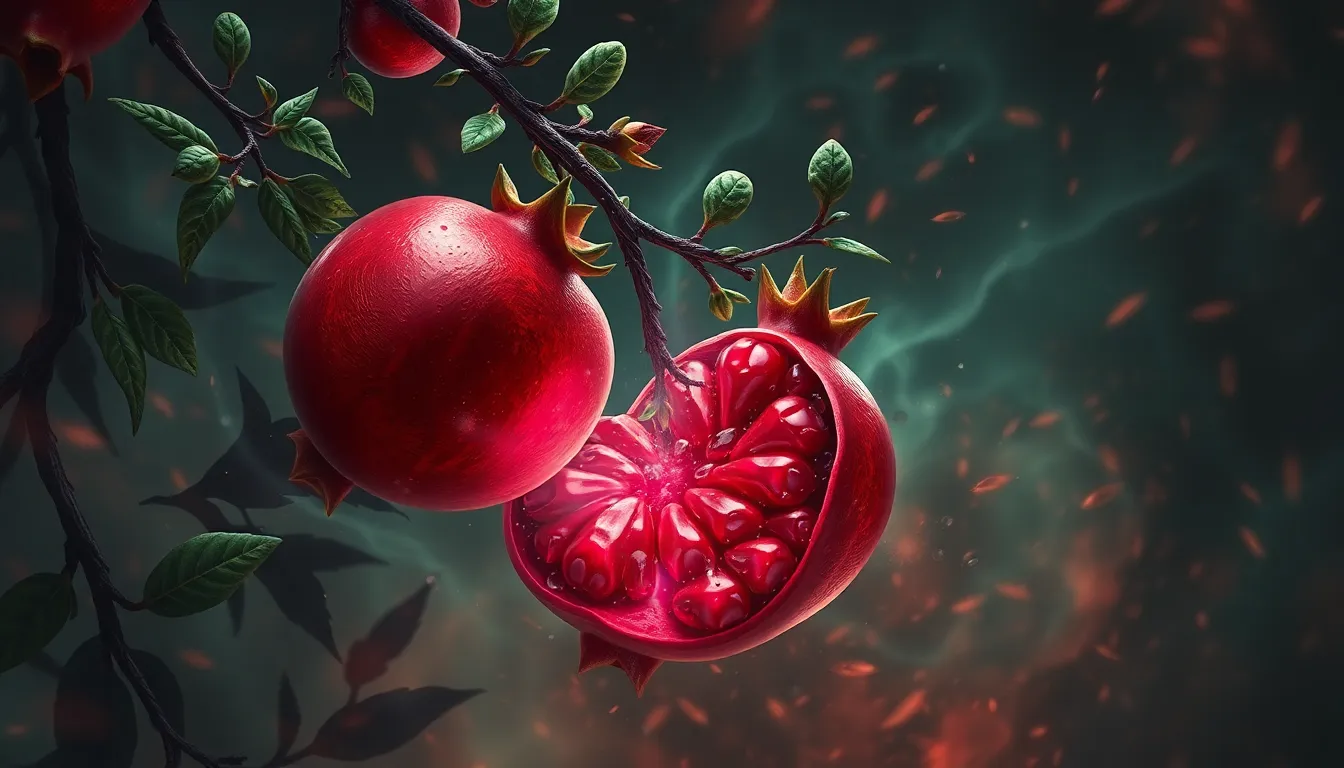The Sacred Pomegranate: Myths of Life and Death
I. Introduction
The pomegranate, with its jewel-like seeds and rich, tart flavor, has long been revered as a potent symbol across various cultures worldwide. This ancient fruit is often associated with themes of life, fertility, and the duality of existence—life and death, creation and destruction. Its significance can be traced back through centuries of mythological narratives that explore the complexities of human existence.
This article aims to delve into the historical context of the pomegranate, examining its role in ancient mythologies, its symbolism in fertility and abundance, and its interpretations as a bridge between life and death. Through this exploration, we will uncover the multifaceted nature of the pomegranate and its enduring presence in cultural narratives.
II. Historical Context of the Pomegranate
The pomegranate’s origins can be traced back to the ancient civilizations of the Mediterranean and the Near East, where it was cultivated for thousands of years. Archaeological evidence suggests that the pomegranate was one of the earliest domesticated fruits, with its cultivation dating back to around 3000 BCE in regions that include modern-day Iran and Iraq.
In early societies, the pomegranate was more than just a food source; it held deep agricultural significance. The fruit’s abundance of seeds symbolized fertility and the cycle of life, making it a staple in rituals and celebrations of harvest. Over time, the pomegranate transitioned from a natural symbol to a revered cultural icon, appearing in art, literature, and religious texts.
III. The Pomegranate in Ancient Mythology
A. Greek Mythology: The Tale of Persephone and Hades
One of the most famous myths involving the pomegranate is the story of Persephone, the daughter of Demeter, and her abduction by Hades, the god of the Underworld. According to the myth, Hades offered Persephone pomegranate seeds, and upon eating them, she was compelled to return to the Underworld for part of the year.
1. The Symbolism of the Pomegranate Seeds
The pomegranate seeds symbolize the cycle of life and death, as Persephone’s consumption of the seeds ties her to the Underworld, marking the changing of seasons. Her annual return to the surface world signifies spring and rebirth, while her descent into the Underworld represents winter and death.
2. Themes of Cyclical Life and Seasonal Change
This myth encapsulates the duality of existence, where the pomegranate serves as a reminder of the interconnectedness of life and death, growth and decay. As Persephone transitions between the worlds, so too does the natural cycle of the earth.
B. Near Eastern Myths: The Goddess Inanna and Her Descent
Inanna, the Sumerian goddess of love and war, also has a compelling myth that involves the pomegranate. Her descent into the Underworld to visit her sister Ereshkigal is marked by various trials and tribulations.
1. The Role of the Pomegranate in Fertility and Rebirth
Inanna’s journey highlights the importance of death as a precursor to rebirth, with the pomegranate often linked to fertility and the rejuvenation of life following winter’s grasp. The fruit symbolizes the life-giving aspects of nature, reinforcing its association with female power and sexuality.
2. Connections to the Underworld
As with the myth of Persephone, the pomegranate in Inanna’s story represents the link between the living and the dead, illuminating how fertility and mortality are intertwined in mythological narratives.
IV. Pomegranate as a Symbol of Fertility and Abundance
The pomegranate has been a potent symbol of fertility and abundance throughout history. In ancient art and literature, it is frequently depicted alongside goddesses and fertility figures, emphasizing its role in creation and the nurturing of life.
Cultural practices surrounding the pomegranate often include:
- Rituals associated with harvest festivals.
- Ceremonies invoking fertility and prosperity.
- Offerings made to deities of fertility.
In contemporary culture, the pomegranate continues to symbolize fertility, appearing in various art forms and wellness practices, serving as an emblem of life’s potential and abundance.
V. The Duality of Life and Death
The pomegranate’s rich symbolism extends into the realm of death and the afterlife. In many cultures, it is seen as a powerful symbol in funerary practices and rituals.
A. The Pomegranate’s Portrayal in Death Rituals
In ancient burial customs, pomegranates were often placed in tombs as offerings, believed to provide sustenance for the deceased in the afterlife. This practice exemplifies the belief in a continued journey beyond death.
B. Interpretations as a Bridge Between Life and the Afterlife
The pomegranate serves as a bridge between the realms of the living and the dead, symbolizing the cyclical nature of existence, where life and death are two interconnected states of being.
C. The Balance of Creation and Destruction in Pomegranate Folklore
Folklore surrounding the pomegranate often reflects a balance between creation and destruction, illustrating how life emerges from death and how every ending leads to a new beginning.
VI. Regional Variations of Pomegranate Myths
A. The Pomegranate in Hindu Mythology
In Hindu mythology, the pomegranate is associated with life cycles and fertility. It is often depicted in the context of various deities and is seen as a symbol of prosperity and abundance.
B. The Significance in Persian Culture and Poetry
Pomegranates hold a revered place in Persian culture, symbolizing love, fertility, and the beauty of life. Persian poets frequently reference the fruit in their works, using it as a metaphor for the richness of existence.
C. Indigenous Interpretations
Indigenous cultures across the globe have their interpretations of the pomegranate, often linking it to local creation myths, fertility rites, and healing practices, showcasing its universal significance.
VII. The Pomegranate in Religion
A. The Pomegranate in Judaism
In Judaism, the pomegranate is a symbol of righteousness and the afterlife. It is often depicted in religious texts and is one of the symbols used during the Jewish New Year, Rosh Hashanah.
B. Christian Symbolism
In Christian symbolism, the pomegranate represents resurrection and eternal life, often associated with the resurrection of Christ. It is depicted in various artworks and religious iconography.
C. The Pomegranate in Islamic Culture
In Islamic culture, the pomegranate is regarded as a symbol of paradise and divine blessings, mentioned in the Quran as a fruit of the Garden of Eden, reinforcing its sacred status across religions.
VIII. Modern Interpretations and Cultural Impact
In contemporary society, the pomegranate has experienced a resurgence as a motif in art, literature, and wellness practices. Artists and writers draw upon its rich symbolism to explore themes of life, death, and rebirth.
The fruit’s role in modern spirituality emphasizes its association with health and vitality, making it a popular ingredient in health foods and wellness products.
Through its enduring presence in culture, the pomegranate continues to inspire and evoke deep reflections on the human experience, celebrating the intricate dance of life and death.



